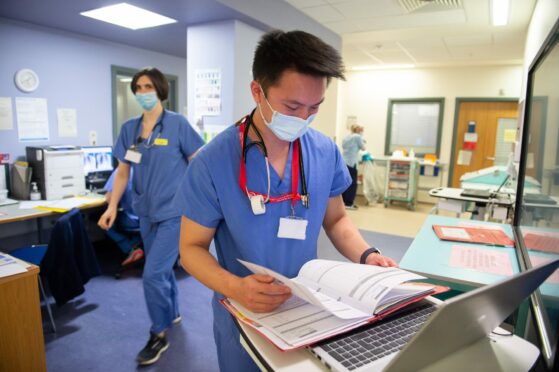
Overstretched hospitals could be crushed by Omicron cases within days, one of Scotland’s most senior doctors warned yesterday.
Dr John Thomson, vice-president of The Royal College of Emergency Medicine (RCEM) Scotland, said there simply aren’t enough beds to cope with a wave of new hospitalisations. Before the pandemic RCEM estimated Scotland’s NHS was 600 beds short and that figure is now thought to be at least 1,000.
The number of hospital admissions fell by a quarter in the last month but a sharp increase is predicted in the latest Scottish Government modelling. The report said the rapid rise in Omicron infections could put significant additional pressure on hospitals and other health and care services.
It is unclear how dangerous Omicron is but modellers believe if there is a huge spike in infection, a rise in serious cases is inevitable. First Minister Nicola Sturgeon said on Friday more patients will need hospital care, putting huge strain on the ability of the NHS to cope.
Thomson said: “The situation at the moment is utterly demoralising. We had a 25% reduction in hospital admissions in the last month or so but when you see the doubling time of Omicron then you know there is going to be a big increase.
“We’re going to see a significant hit in a shorter period of time. With Delta, it was over a longer period of time. We’re now going to get that number of patients that require admission to hospital in a shorter period of time and we’re already really struggling with capacity.
“Covid is part of the issue but not all patients come to the emergency department with Covid. What we’re seeing is huge challenges for all patients presenting to emergency departments, where they are spending significantly long periods of time.
“If we then see a significant increase in the number of unwell patients presenting due to infections it’s going to worsen that situation. We are going to see a deterioration in the patients’ experience. We will see an increased number of ambulance stacking, we’ll see an increased number of delays.
Scots warned of more restrictions as Omicron surges across country
“We know associated with that is increased harm to patients who are there for one, two, possibly three days. We’ve had evidence of that in the last few weeks – patients into their third day waiting for a bed.”
The latest monthly figures for A&E show the worst performance on record, with more than one in four people waiting more than four hours to be seen in October.
Thomson said part of the problem is exit block – when there are no beds for patients waiting in emergency departments. He said ministers must take immediate action to increase hospital capacity.
He said: “There are only two possible short-term mitigations. One is to ensure all patients in a hospital bed that no longer require hospital care are moved out. The other thing is to look at alternatives to admission, what some people call ambulatory care. There is an increased number of presentations that could be safely managed without admitting a patient to hospital. They could be managed as an outpatient but those services need to run 12 hours a day, seven days a week.
“The truth is, in the majority of places they don’t even exist. Where they do exist they run for eight hours a day, five days a week. If you present on a Saturday or Sunday we have no option but to admit you because the safe outpatient pathway doesn’t exist.”
Omicron is already forcing the closure of some wards and leading to the isolation of dozens of hospital staff.
Around 40 A&E workers at Hairmyres Hospital in South Lanarkshire are self-isolating following an outbreak of Omicron linked to their Christmas party. Wards 7a and 5a at Raigmore Hospital, in Inverness, has been closed to new admissions after Covid outbreaks.
Meanwhile, Scottish Lib Dem leader Alex Cole-Hamilton has called for a citizens’ assembly-style initiative to involve all NHS staff to help shape executives’ strategy as they try to manage the crisis.
He said: “Their personal experience is invaluable and should be at the heart of the conversation on NHS recovery.”
The Scottish Government said the spread of the variant has increased pressure on the NHS and ministers are in daily contact with every board and will react as necessary.

Enjoy the convenience of having The Sunday Post delivered as a digital ePaper straight to your smartphone, tablet or computer.
Subscribe for only £5.49 a month and enjoy all the benefits of the printed paper as a digital replica.
Subscribe